2010 JAGUAR XFR warning
[x] Cancel search: warningPage 19 of 3039

Blower Motor Control Module
Center Registers
Climate Control Assembly
Climate Control Module
Defrost Vent/Register Blend Door Actuator
Driver Side Register
Evaporator
Floor Console Register
Footwell Vent/Duct Blend Door Actuator
Heater Core
Heater Core and Evaporator Core Housing
Instrument Panel Register Trim Panel
In-Vehicle Temperature Sensor
Passenger Side Register
Pollen Filter
Recirculation Blend Door Actuator
Sunload Sensor
Thermostatic Expansion Valve
Desiccant Bag - V6 3.0L Petrol/V8 5.0L Petrol/V8 S/C 5.0L Petrol412-02: Auxiliary Climate ControlSpecificationDescription and OperationComponent Location
System Operation and Component DescriptionRemoval and InstallationAuxiliary Coolant Flow Pump
Electric Booster Heater412-03: Air ConditioningSpecificationDiagnosis and TestingAir ConditioningRemoval and InstallationAir Conditioning (A/C) Compressor - V8 5.0L Petrol/V8 S/C 5.0L Petrol
Condenser Core - V8 S/C 5.0L Petrol
Pressure Cutoff Switch (82.10.32)413: Instrumentation and Warning Systems
413-01: Instrument ClusterSpecificationDescription and OperationComponent Location
Overview
System Operation and Component Description
Page 20 of 3039

Diagnosis and TestingInstrument ClusterRemoval and InstallationInstrument Cluster
Instrument Cluster Lens413-06: HornSpecificationRemoval and InstallationHorn
Horn Switch413-08: Information and Message Center
Description and OperationComponent Location
Overview
System Operation and Component DescriptionDiagnosis and TestingInformation and Message Center413-09: Warning Devices
Description and OperationComponent Location
Overview
System Operation and Component DescriptionDiagnosis and TestingWarning Devices413-13: Parking Aid
Description and OperationComponent Location
Overview
System Operation and Component DescriptionDiagnosis and TestingParking Aid
Proximity CameraRemoval and InstallationFront Inner Parking Aid Sensor
Front Outer Parking Aid Sensor
Parking Aid Camera
Parking Aid Module
Rear Parking Aid Sensor414: Battery and Charging System
414-00: Battery and Charging System - General Information
Description and OperationBattery Care Requirements
Page 34 of 3039
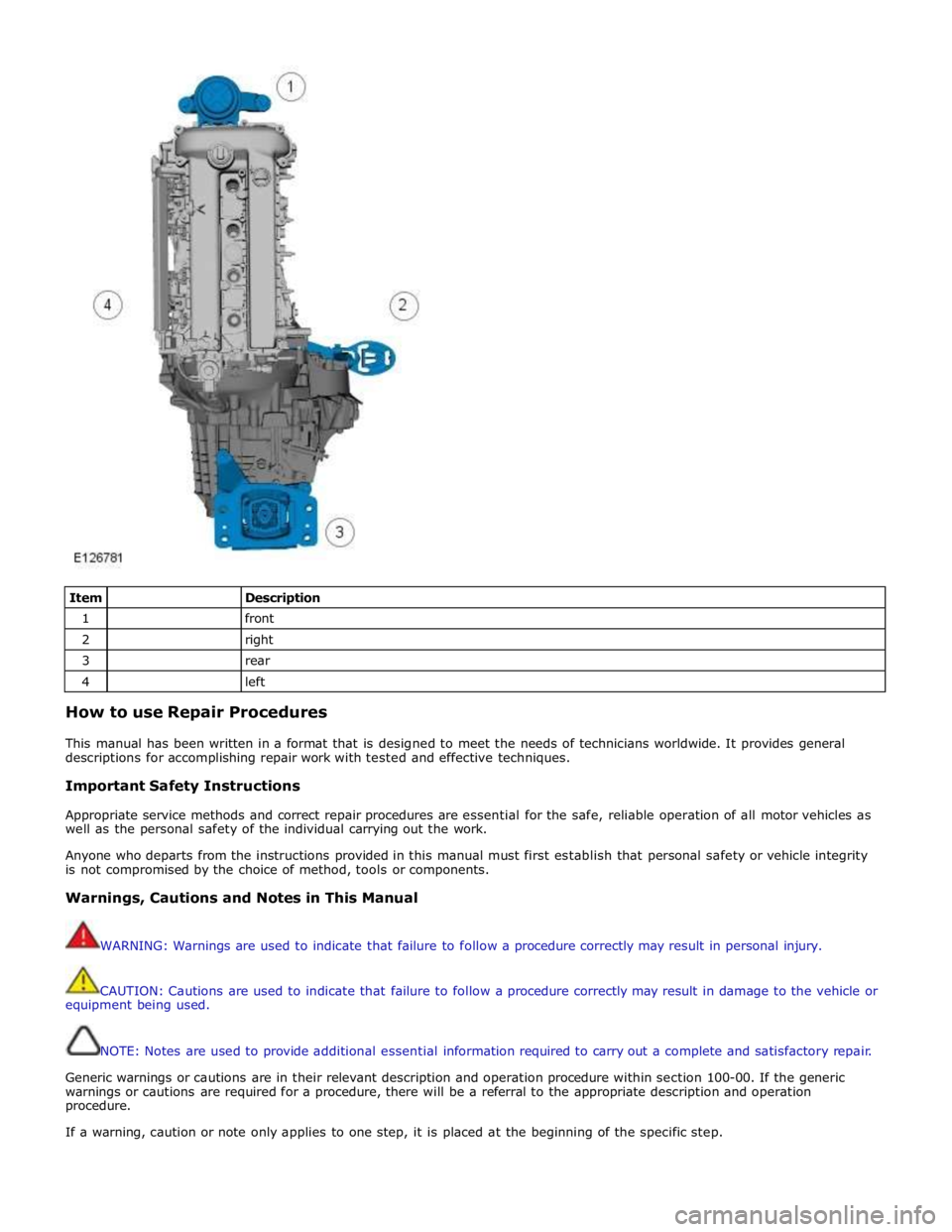
Item
Description 1
front 2
right 3
rear 4
left How to use Repair Procedures
This manual has been written in a format that is designed to meet the needs of technicians worldwide. It provides general
descriptions for accomplishing repair work with tested and effective techniques.
Important Safety Instructions
Appropriate service methods and correct repair procedures are essential for the safe, reliable operation of all motor vehicles as
well as the personal safety of the individual carrying out the work.
Anyone who departs from the instructions provided in this manual must first establish that personal safety or vehicle integrity
is not compromised by the choice of method, tools or components.
Warnings, Cautions and Notes in This Manual
WARNING: Warnings are used to indicate that failure to follow a procedure correctly may result in personal injury.
CAUTION: Cautions are used to indicate that failure to follow a procedure correctly may result in damage to the vehicle or
equipment being used.
NOTE: Notes are used to provide additional essential information required to carry out a complete and satisfactory repair.
Generic warnings or cautions are in their relevant description and operation procedure within section 100-00. If the generic
warnings or cautions are required for a procedure, there will be a referral to the appropriate description and operation
procedure.
If a warning, caution or note only applies to one step, it is placed at the beginning of the specific step.
Page 45 of 3039
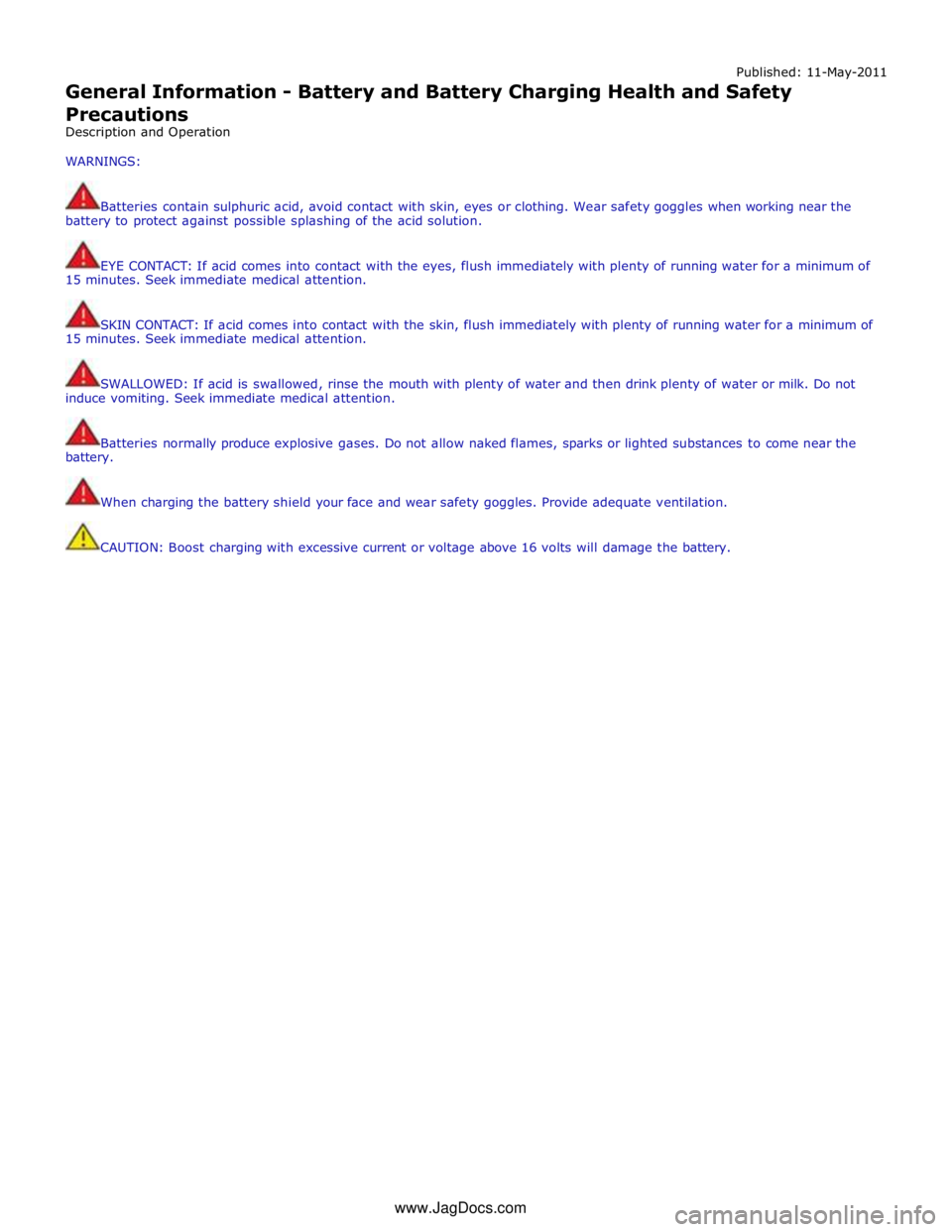
Published: 11-May-2011
General Information - Battery and Battery Charging Health and Safety Precautions
Description and Operation
WARNINGS:
Batteries contain sulphuric acid, avoid contact with skin, eyes or clothing. Wear safety goggles when working near the
battery to protect against possible splashing of the acid solution.
EYE CONTACT: If acid comes into contact with the eyes, flush immediately with plenty of running water for a minimum of
15 minutes. Seek immediate medical attention.
SKIN CONTACT: If acid comes into contact with the skin, flush immediately with plenty of running water for a minimum of
15 minutes. Seek immediate medical attention.
SWALLOWED: If acid is swallowed, rinse the mouth with plenty of water and then drink plenty of water or milk. Do not
induce vomiting. Seek immediate medical attention.
Batteries normally produce explosive gases. Do not allow naked flames, sparks or lighted substances to come near the
battery.
When charging the battery shield your face and wear safety goggles. Provide adequate ventilation.
CAUTION: Boost charging with excessive current or voltage above 16 volts will damage the battery.
www.JagDocs.com
Page 46 of 3039
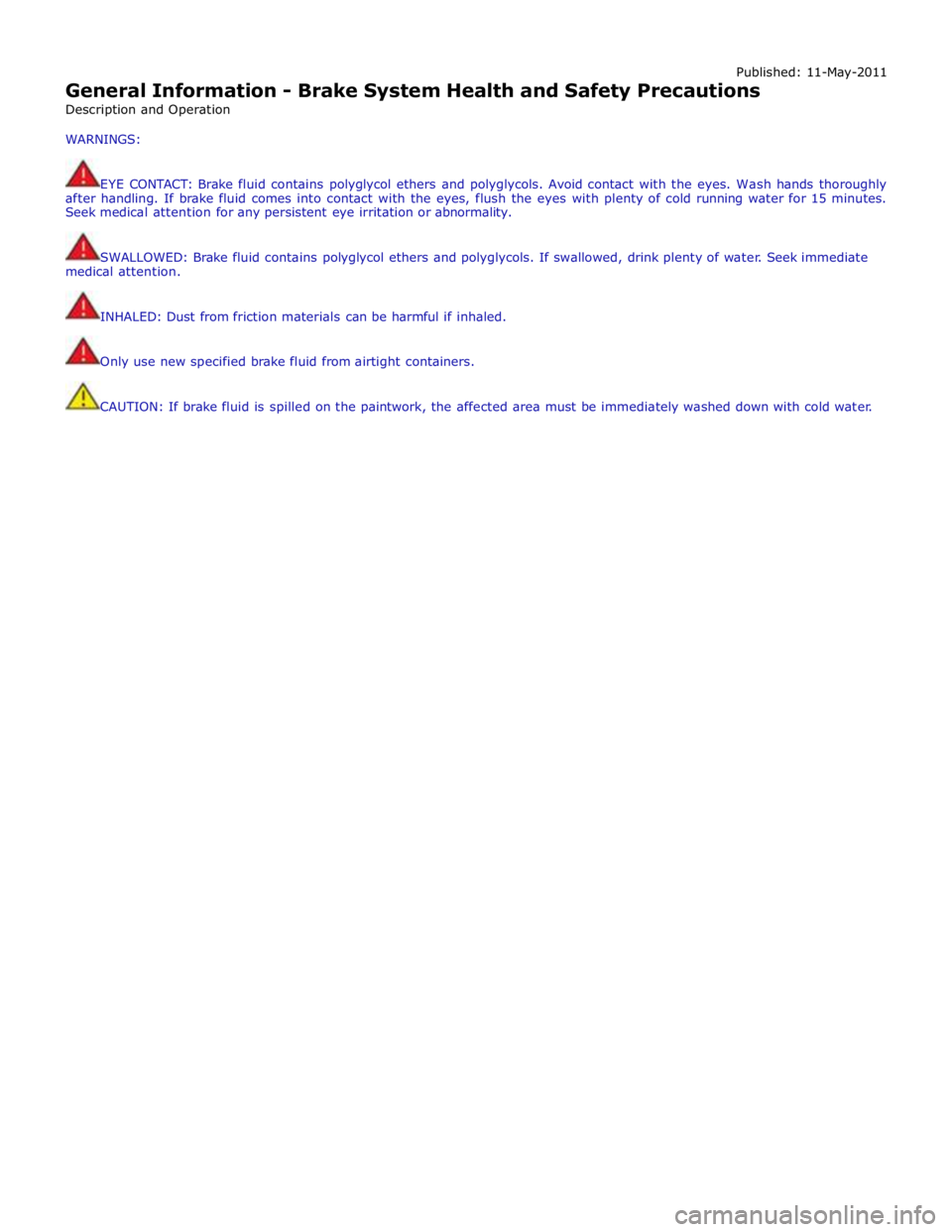
Published: 11-May-2011
General Information - Brake System Health and Safety Precautions
Description and Operation
WARNINGS:
EYE CONTACT: Brake fluid contains polyglycol ethers and polyglycols. Avoid contact with the eyes. Wash hands thoroughly
after handling. If brake fluid comes into contact with the eyes, flush the eyes with plenty of cold running water for 15 minutes.
Seek medical attention for any persistent eye irritation or abnormality.
SWALLOWED: Brake fluid contains polyglycol ethers and polyglycols. If swallowed, drink plenty of water. Seek immediate
medical attention.
INHALED: Dust from friction materials can be harmful if inhaled.
Only use new specified brake fluid from airtight containers.
CAUTION: If brake fluid is spilled on the paintwork, the affected area must be immediately washed down with cold water.
Page 47 of 3039
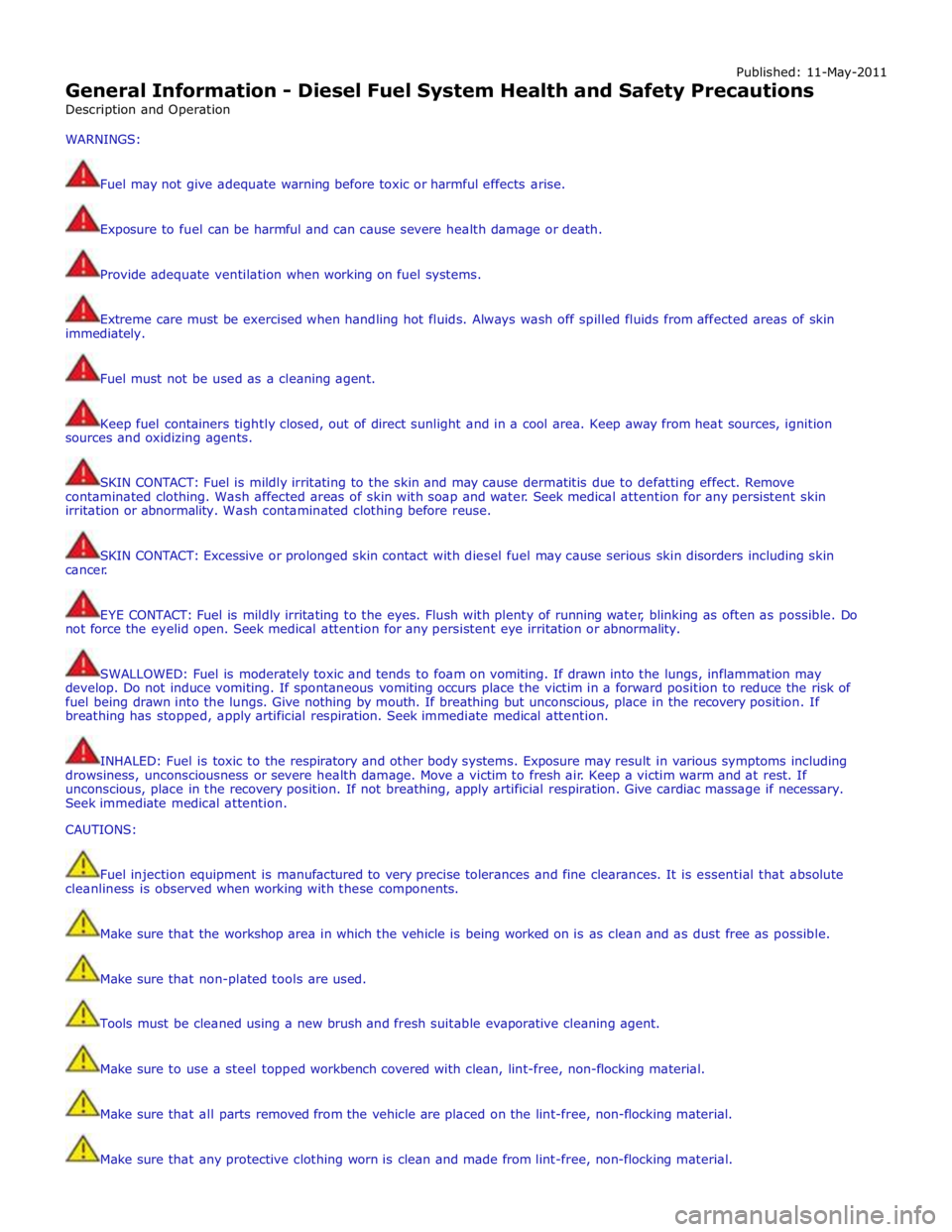
Published: 11-May-2011
General Information - Diesel Fuel System Health and Safety Precautions
Description and Operation
WARNINGS:
Fuel may not give adequate warning before toxic or harmful effects arise.
Exposure to fuel can be harmful and can cause severe health damage or death.
Provide adequate ventilation when working on fuel systems.
Extreme care must be exercised when handling hot fluids. Always wash off spilled fluids from affected areas of skin
immediately.
Fuel must not be used as a cleaning agent.
Keep fuel containers tightly closed, out of direct sunlight and in a cool area. Keep away from heat sources, ignition
sources and oxidizing agents.
SKIN CONTACT: Fuel is mildly irritating to the skin and may cause dermatitis due to defatting effect. Remove
contaminated clothing. Wash affected areas of skin with soap and water. Seek medical attention for any persistent skin
irritation or abnormality. Wash contaminated clothing before reuse.
SKIN CONTACT: Excessive or prolonged skin contact with diesel fuel may cause serious skin disorders including skin
cancer.
EYE CONTACT: Fuel is mildly irritating to the eyes. Flush with plenty of running water, blinking as often as possible. Do
not force the eyelid open. Seek medical attention for any persistent eye irritation or abnormality.
SWALLOWED: Fuel is moderately toxic and tends to foam on vomiting. If drawn into the lungs, inflammation may
develop. Do not induce vomiting. If spontaneous vomiting occurs place the victim in a forward position to reduce the risk of
fuel being drawn into the lungs. Give nothing by mouth. If breathing but unconscious, place in the recovery position. If
breathing has stopped, apply artificial respiration. Seek immediate medical attention.
INHALED: Fuel is toxic to the respiratory and other body systems. Exposure may result in various symptoms including
drowsiness, unconsciousness or severe health damage. Move a victim to fresh air. Keep a victim warm and at rest. If
unconscious, place in the recovery position. If not breathing, apply artificial respiration. Give cardiac massage if necessary.
Seek immediate medical attention.
CAUTIONS:
Fuel injection equipment is manufactured to very precise tolerances and fine clearances. It is essential that absolute
cleanliness is observed when working with these components.
Make sure that the workshop area in which the vehicle is being worked on is as clean and as dust free as possible.
Make sure that non-plated tools are used.
Tools must be cleaned using a new brush and fresh suitable evaporative cleaning agent.
Make sure to use a steel topped workbench covered with clean, lint-free, non-flocking material.
Make sure that all parts removed from the vehicle are placed on the lint-free, non-flocking material.
Make sure that any protective clothing worn is clean and made from lint-free, non-flocking material.
Page 48 of 3039
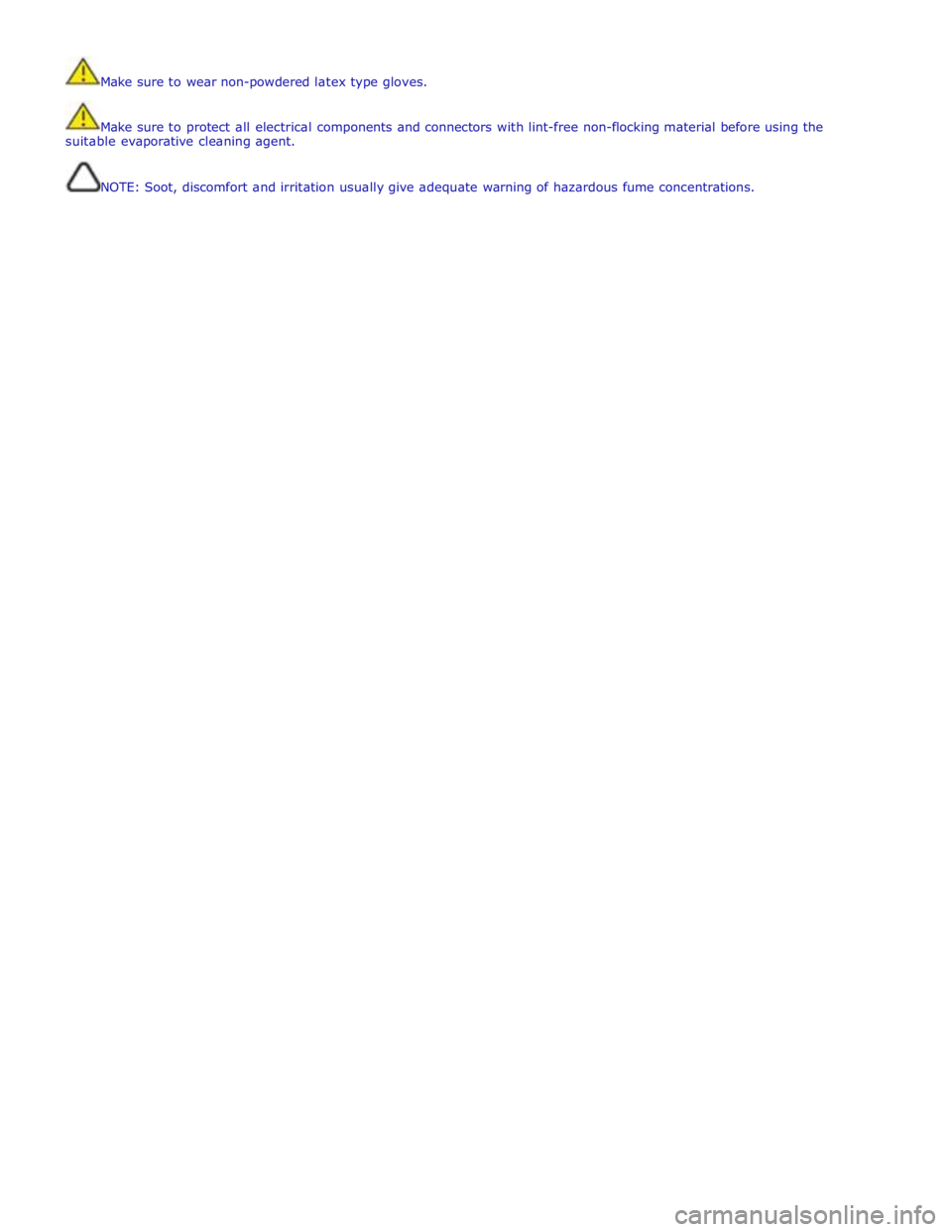
Make sure to wear non-powdered latex type gloves.
Make sure to protect all electrical components and connectors with lint-free non-flocking material before using the
suitable evaporative cleaning agent.
NOTE: Soot, discomfort and irritation usually give adequate warning of hazardous fume concentrations.
Page 49 of 3039
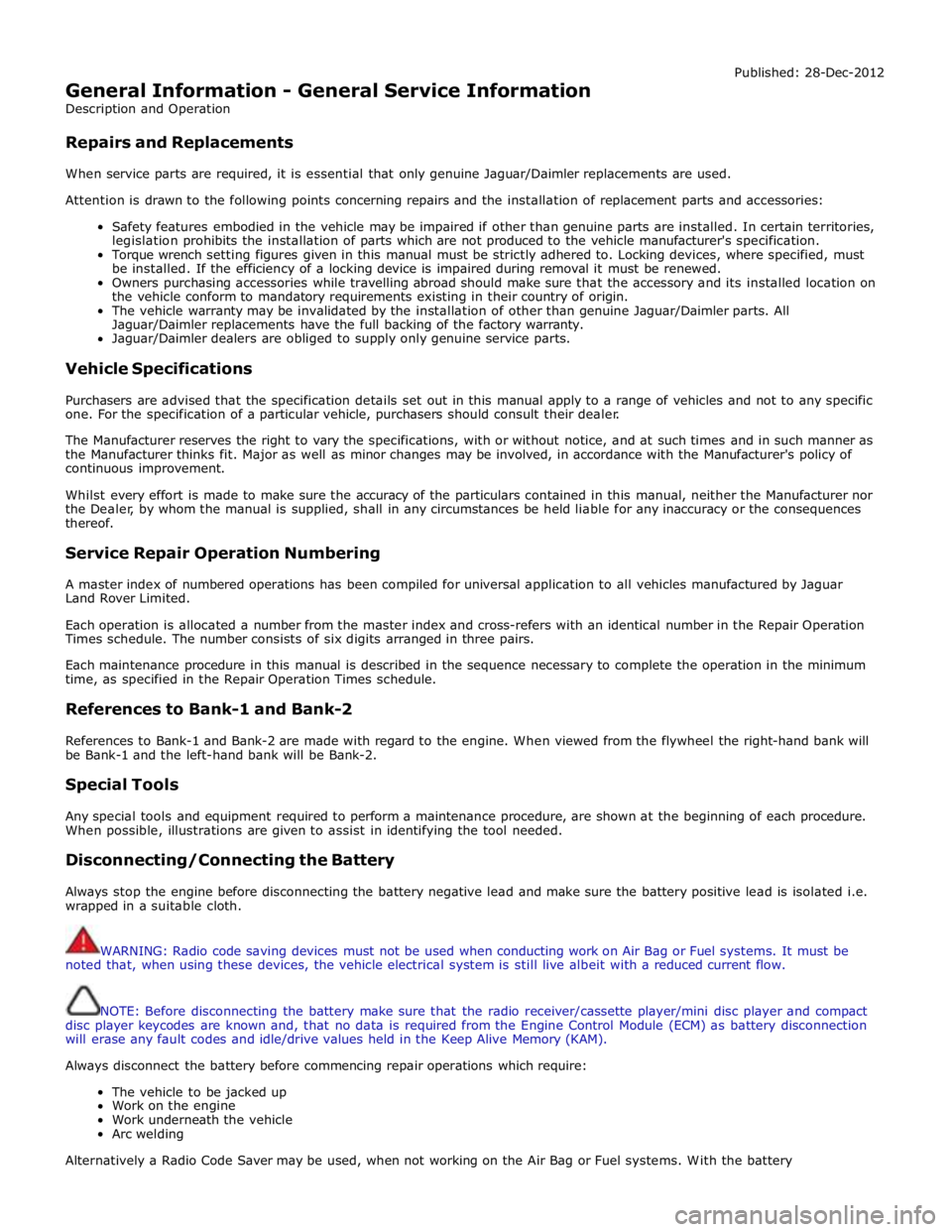
General Information - General Service Information
Description and Operation
Repairs and Replacements Published: 28-Dec-2012
When service parts are required, it is essential that only genuine Jaguar/Daimler replacements are used.
Attention is drawn to the following points concerning repairs and the installation of replacement parts and accessories:
Safety features embodied in the vehicle may be impaired if other than genuine parts are installed. In certain territories,
legislation prohibits the installation of parts which are not produced to the vehicle manufacturer's specification.
Torque wrench setting figures given in this manual must be strictly adhered to. Locking devices, where specified, must
be installed. If the efficiency of a locking device is impaired during removal it must be renewed.
Owners purchasing accessories while travelling abroad should make sure that the accessory and its installed location on
the vehicle conform to mandatory requirements existing in their country of origin.
The vehicle warranty may be invalidated by the installation of other than genuine Jaguar/Daimler parts. All
Jaguar/Daimler replacements have the full backing of the factory warranty.
Jaguar/Daimler dealers are obliged to supply only genuine service parts.
Vehicle Specifications
Purchasers are advised that the specification details set out in this manual apply to a range of vehicles and not to any specific
one. For the specification of a particular vehicle, purchasers should consult their dealer.
The Manufacturer reserves the right to vary the specifications, with or without notice, and at such times and in such manner as
the Manufacturer thinks fit. Major as well as minor changes may be involved, in accordance with the Manufacturer's policy of
continuous improvement.
Whilst every effort is made to make sure the accuracy of the particulars contained in this manual, neither the Manufacturer nor
the Dealer, by whom the manual is supplied, shall in any circumstances be held liable for any inaccuracy or the consequences
thereof.
Service Repair Operation Numbering
A master index of numbered operations has been compiled for universal application to all vehicles manufactured by Jaguar
Land Rover Limited.
Each operation is allocated a number from the master index and cross-refers with an identical number in the Repair Operation
Times schedule. The number consists of six digits arranged in three pairs.
Each maintenance procedure in this manual is described in the sequence necessary to complete the operation in the minimum
time, as specified in the Repair Operation Times schedule.
References to Bank-1 and Bank-2
References to Bank-1 and Bank-2 are made with regard to the engine. When viewed from the flywheel the right-hand bank will
be Bank-1 and the left-hand bank will be Bank-2.
Special Tools
Any special tools and equipment required to perform a maintenance procedure, are shown at the beginning of each procedure.
When possible, illustrations are given to assist in identifying the tool needed.
Disconnecting/Connecting the Battery
Always stop the engine before disconnecting the battery negative lead and make sure the battery positive lead is isolated i.e.
wrapped in a suitable cloth.
WARNING: Radio code saving devices must not be used when conducting work on Air Bag or Fuel systems. It must be
noted that, when using these devices, the vehicle electrical system is still live albeit with a reduced current flow.
NOTE: Before disconnecting the battery make sure that the radio receiver/cassette player/mini disc player and compact
disc player keycodes are known and, that no data is required from the Engine Control Module (ECM) as battery disconnection
will erase any fault codes and idle/drive values held in the Keep Alive Memory (KAM).
Always disconnect the battery before commencing repair operations which require:
The vehicle to be jacked up
Work on the engine
Work underneath the vehicle
Arc welding
Alternatively a Radio Code Saver may be used, when not working on the Air Bag or Fuel systems. With the battery